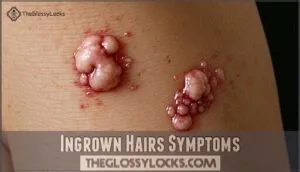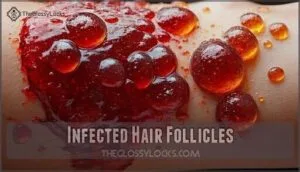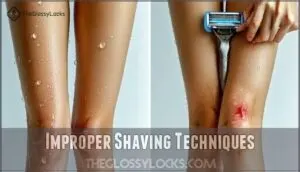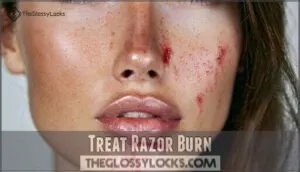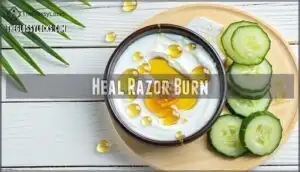This site is supported by our readers. We may earn a commission, at no cost to you, if you purchase through links.
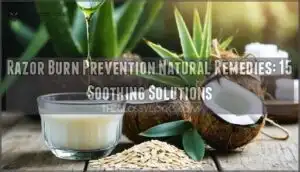
Apply aloe vera gel or coconut oil to damp skin—they’re like a shield that reduces friction and inflammation.
Use a warm compress before shaving to open pores, then follow up with oatmeal paste for instant cooling relief.
Tea tree oil mixed with carrier oil works wonders for antibacterial protection, while cold green tea bags reduce redness fast.
These razor burn prevention natural remedies don’t just treat symptoms—they actually heal your skin from the inside out.
The secret lies in timing and combining specific ingredients for maximum effectiveness.
Table Of Contents
- Key Takeaways
- Prevent Razor Burns
- Razor Burn Remedies
- Causes Razor Bumps
- Treat Razor Burn
- Heal Razor Burn
- Frequently Asked Questions (FAQs)
- How do you stop razor burn from forming?
- What is the best natural thing after shaving?
- Does coconut oil help razor burn?
- What helps prevent razor burn down there?
- Can diet affect razor burn frequency?
- Are electric razors better for sensitive skin?
- What clothing materials worsen razor burn irritation?
- How does weather humidity impact shaving results?
- Should men and women use different techniques?
- Conclusion
Key Takeaways
- Create a protective barrier before shaving – Apply aloe vera gel or coconut oil to damp skin to reduce friction and inflammation, then use a warm compress to open pores and soften hair for smoother shaving.
- Master proper shaving technique and timing – Always shave with hair growth using a sharp razor at a 30-degree angle, replace blades every 5-7 uses, and maintain a consistent shaving frequency of every 2-3 days to prevent irritation.
- Use natural healing remedies for immediate relief – Apply tea tree oil mixed with carrier oil for antibacterial protection, try oatmeal baths for cooling relief, and use cold green tea bags to reduce redness when razor burn occurs.
- Focus on post-shave care and prevention – Exfoliate weekly to remove dead skin cells, moisturize immediately after shaving with natural ingredients, and avoid synthetic fabrics that can worsen irritation through friction and heat retention.
Prevent Razor Burns
You can prevent razor burns by using proper shaving techniques, quality products, and consistent skin care habits.
Simple steps like hot compresses, sharp razors, and moisturizing creams protect your skin from irritation and keep shaving comfortable.
Hot Compress Benefits
Before you even think about reaching for that razor, grab a hot compress – it’s your skin’s best friend.
Your razor can wait – your skin deserves the hot compress treatment first.
This simple pore opening technique softens stubborn hair shafts while boosting circulation to reduce future inflammation.
Whether you use a warm washcloth or heated towel, this natural remedy preps your skin perfectly, making shaving smoother and preventing those angry razor burn flare-ups, which is a great way to achieve smoother shaving.
Moisturizing Shaving Creams
Quality moisturizing shaving cream transforms your shaving routine from torture into comfort.
These protective barriers contain essential cream ingredients like glycerin and aloe vera that shield your skin while you shave.
Post-shave, it’s important to address skin’s barrier function with moisturizer.
Here’s what makes the difference:
- Glycerin-based formulas provide superior hydration compared to basic shaving cream alternatives
- Coconut oil blends create natural lubrication for sensitive skin types
- Application techniques matter – let cream sit 1-2 minutes before shaving
- DIY recipes using shea butter offer chemical-free options
- Shaving oil combinations enhance protection for extra-sensitive areas
Frequent Razor Changes
After five to seven shaves, your razor blade loses its edge and starts tugging at hair instead of cutting cleanly.
This blade sharpness decline causes razor burn prevention to fail dramatically.
Replace blades every 10-15 uses maximum to maintain razor hygiene and ideal shaving frequency.
Yes, frequent razor changes increase costs, but the razor lifespan investment prevents painful razor burn remedies later.
Correct Shaving Techniques
Proper shaving direction makes all the difference in preventing irritation.
Always shave with hair growth, not against it—this single technique reduces ingrown hairs by 80%.
Maintain a 30-degree blade angle and use gentle, short strokes.
Your pre-shave routine should include warm water to soften hair.
These shaving tips transform your daily routine into a comfortable experience.
Exfoliating Skin
Dead skin cells create a breeding ground for razor burn and ingrown hairs.
You’ll want to exfoliate at least once weekly using gentle physical exfoliation techniques like sugar scrubs or washcloths. Chemical exfoliants work well for sensitive skin types.
Regular skin exfoliation removes 70% more dead skin than washing alone, creating smoother shaving surfaces and reducing irritation substantially.
Shaving every other day allows for essential skin recovery, which is a critical step in preventing razor burn, as it enables essential skin healing, and helps maintain smooth skin.
Razor Burn Remedies
When razor burn strikes, you don’t need expensive treatments to find relief.
Natural remedies from your kitchen and medicine cabinet can soothe irritated skin, reduce redness, and speed up healing without harsh chemicals.
Aloe Vera Gel Applications
Aloe vera gel acts like nature’s cooling balm for razor burn relief. Apply fresh gel twice daily to irritated skin for maximum aloe vera benefits.
Store opened gel in your refrigerator to maintain potency and provide extra cooling comfort. This natural remedy’s anti-inflammatory properties calm redness while moisturizing damaged skin.
Different aloe types work equally well for sensitive skin use. You can also try applying cool compresses for immediate relief.
Tea Tree Oil Benefits
Tea tree oil benefits include powerful natural antiseptic and anti-inflammatory properties that provide effective razor burn relief.
You’ll discover this natural remedy offers antifungal properties and excellent acne treatment capabilities.
Its wound healing compounds soothe irritated skin while reducing redness.
Always dilute tea tree oil with carrier oils before applying to prevent skin irritation.
It’s also used as a <strong>topical remedy</strong> for insect bites and burns.
Coconut Oil Uses
Coconut oil works like nature’s healing balm for razor burn relief.
Its antimicrobial effects fight bacteria while anti-inflammatory properties calm angry skin.
You’ll find it provides excellent skin hydration and promotes wound healing naturally.
Apply coconut oil directly to affected areas or mix it with honey for enhanced skin soothing benefits during your natural remedies routine.
Oatmeal Bath Soaks
Soaking in an oatmeal bath soak delivers powerful skin soothing properties that calm irritated areas naturally.
Nature’s gentle remedy works wonders—oatmeal baths provide instant relief for angry, razor-burned skin.
You’ll find immediate itch relief as oatmeal’s antiinflammatory compounds work their magic.
For soak preparation tips, blend one cup colloidal oatmeal into warm bathwater. Recipe variations include adding honey or milk for extra moisture.
These natural remedies provide gentle healing without harsh chemicals.
Natural Ingredient Sprays
When irritation strikes after shaving, natural ingredient sprays offer quick relief you can make at home.
DIY razor burn spray recipes combine aloe vera and chamomile for cooling spray benefits that calm inflammation instantly. Essential oil blends with tea tree provide antimicrobial protection.
You can find products related to DIY razor burn online.
For spray storage tips, refrigerate your homemade mixture and apply using gentle spray application methods twice daily.
Causes Razor Bumps
You’ve likely experienced those painful, red bumps that appear after shaving, but understanding what causes them can help you prevent future irritation.
Razor bumps occur when bacteria infect your hair follicles, often due to improper shaving techniques, dull razors, or shaving sensitive areas without proper preparation, which can lead to irritation.
Ingrown Hairs Symptoms
Three telltale signs signal ingrown hairs are wreaking havoc on your skin.
You’ll notice painful bumps that feel tender to touch, accompanied by persistent redness itching that won’t quit.
A burning sensation often follows, creating uncomfortable skin inflammation.
These symptoms indicate your hair’s curved back into the skin, requiring prompt ingrown hair treatment to prevent worsening bump severity.
Infected Hair Follicles
When folliculitis develops, bacteria invade damaged hair follicles after shaving.
This skin infection creates painful, pus-filled bumps that look worse than regular razor bumps.
Bacterial growth thrives in warm, moist conditions, leading to these infection causes:
- Staphylococcus aureus bacteria entering through tiny cuts
- Poor hygiene allowing germs to multiply rapidly
- Compromised follicles from aggressive shaving techniques
Severe cases require antiseptic treatment immediately.
Improper Shaving Techniques
Your shaving technique makes all the difference between smooth skin and angry bumps.
Shaving against the grain, pressing too hard, or rushing creates irritation.
Proper shaving direction follows hair growth, maintaining a 30-degree blade angle.
Skip the skin stretching and focus on gentle strokes.
Pre-shave prep softens hair, while consistent shaving frequency prevents ingrown hairs from forming underneath, which is crucial for achieving smooth skin.
Low-Quality Razors
Your razor quality directly impacts shaving irritation and razor burn risk.
Cheap razors often feature poor blade material and awkward handle design, making proper shaving angle nearly impossible to maintain.
One way to extend razor life is to avoid common maintenance mistakes.
Signs you’re using a low-quality razor:
- Blade dulls after 2-3 uses instead of lasting 5-7 shaves
- Handle feels flimsy and doesn’t provide steady control
- Multiple nicks occur even with careful technique
- Razor lifespan ends prematurely with poor blade maintenance
Sensitive Skin Areas
Your body’s delicate zones demand extra attention regarding sensitive skin shaving.
These areas have thinner skin and more nerve endings, making them prone to irritation and razor bumps.
| Sensitive Area | Why It’s Vulnerable |
|---|---|
| Bikini Line | Curved surface, coarse hair |
| Underarms | Thin skin, constant friction |
| Facial Skin | Delicate tissue, visible bumps |
| Scalp Shaving | Irregular contours, sensitivity |
| Neck area | Thin skin, awkward angles |
Post-shave care with aloe vera for skin helps prevent complications.
Treat Razor Burn
When razor burn strikes, you’ll need quick relief to calm that angry, irritated skin.
The good news is that several proven treatments can reduce redness, soothe burning sensations, and speed up your skin’s healing process, which can provide quick relief.
Apply Soothing Gels
Soothing gels work like a cooling balm for angry skin.
Apply aloe vera gel twice daily for its natural antiinflammatories that calm irritation.
Calendula Cream offers gentle relief, while petroleum jelly locks in moisture to heal damaged areas.
For stubborn inflammation, OTC steroids provide stronger antiseptic properties.
Explore various soothing options for different skin types.
When razor burn remedies aren’t working, a dermatologist consult guarantees proper skin calming treatment, ensuring the use of natural antiinflammatories.
Stay Moisturized Always
Moisturizing after shaving isn’t just nice-to-have—it’s your skin’s lifeline. Your skin barrier takes a beating during shaving, so replenishing moisture prevents irritation and promotes healing.
Look for products with natural ingredients that offer real hydration benefits.
- Aloe vera gel creates a protective layer while delivering deep skin moisturization
- Humectant-rich lotions pull moisture from air into your freshly shaved skin
- Post-shave care with coconut oil locks in hydration for lasting skin barrier protection
Take Oatmeal Baths
While keeping your skin hydrated helps, sometimes you need deeper relief.
An oatmeal bath works wonders for razor burn by leveraging oatmeal’s anti-inflammatory properties to calm skin irritation naturally.
Grind one cup of plain oats into fine powder, then dissolve in lukewarm bathwater.
Soak for fifteen minutes to experience itch relief and skin soothing benefits from this gentle natural remedy.
Use Natural Remedies
Natural razor burn remedies work wonders when you’re dealing with angry, irritated skin.
Apply Aloe Vera gel directly to cool inflammation, while Tea Tree oil mixed with Coconut Oil prevents infection.
Honey masks provide antibacterial healing properties.
These natural skin care solutions offer gentle, effective relief without harsh chemicals, making soothing skin after shaving simple and safe with natural remedies.
Consult Doctors
When razor burn spirals into severe cases with persistent redness, hyperpigmentation concerns, or infection symptoms like pus and fever, it’s time to call the professionals.
Your healthcare provider can offer personalized advice that natural remedies simply can’t match.
A dermatology specialist might prescribe steroid cream or advanced skin care remedies customized to your specific needs—because sometimes DIY isn’t enough, and professional help is necessary.
Heal Razor Burn
Once you’ve treated your razor burn, you’ll want to focus on helping your skin heal completely within the typical two to three day recovery period.
The right combination of natural remedies, proper care techniques, and sometimes over-the-counter solutions can speed up healing while preventing future irritation from occurring, which is crucial for a complete healing process.
Healing Time Frames
Most razor burn clears up within 2-3 days with proper care. Your skin’s healing time depends on several factors including severity, skin type, and treatment approach.
While mild cases resolve quickly, severe inflammation might linger for up to two weeks. Watch for infection signs like increased redness or pus formation. Applying cool compresses can reduce irritation.
- Typical Duration: Mild razor burn heals in 2-3 days, severe cases take 2-3 weeks
- Factors Affecting: Skin type, severity level, and continued shaving impact recovery speed
- Infection Signs: Watch for increased redness, pus, or worsening pain beyond normal healing
- Scarring Potential: Proper care prevents permanent marks and discoloration from developing
- When To Worry: Seek medical help if symptoms worsen after 48 hours of treatment
Natural Remedies Accelerate
Several natural razor burn remedies can substantially speed up your skin healing process.
Aloe Vera gel reduces skin inflammation within hours, while Tea Tree oil’s natural astringent properties fight infection.
Coconut Oil moisturizes damaged skin, and Oatmeal Baths soothe irritation overnight.
DIY sprays combining these ingredients create powerful treatments that accelerate recovery faster than waiting alone, using natural remedies.
Prevention Measures
Building a solid pre-shave routine prevents most razor burn issues before they start.
You’ll want to exfoliate weekly, moisturize daily, and maintain proper razor maintenance by replacing blades every 5-7 uses.
Always shave in your hair growth direction, never against it.
Consistent shaving frequency every 2-3 days keeps hair short, while checking product ingredients verifies you’re avoiding harsh chemicals to ensure a smooth shave with proper razor maintenance.
Over-The-Counter Solutions
When natural remedies aren’t cutting it, over-the-counter solutions offer reliable relief for stubborn razor burn.
Steroid cream use reduces inflammation quickly, while calendula cream benefits include gentle soothing properties.
Petroleum jelly uses extend to healing injured skin by locking in moisture.
Choose antiseptic product selection with anti-inflammatory ingredients. Consider dermatologist consultations for persistent irritation requiring professional OTC gel recommendations.
Expert Tips Advice
Medical professionals recommend consulting dermatologists for severe razor burn cases that don’t heal within a week.
They’ll prescribe stronger OTC solutions like antiseptic products or petroleum jelly treatments.
Follow their advice on shaving frequency—typically every 48-72 hours for sensitive skin.
Combine professional postshave care guidance with proven home remedies and natural shaving remedies for ideal razor burn prevention results.
Frequently Asked Questions (FAQs)
How do you stop razor burn from forming?
Tired of turning your face into a tomato?
Use sharp razors, shave with the grain, prep with warm water and quality cream.
Then rinse with cold water and moisturize immediately afterward.
What is the best natural thing after shaving?
Aloe vera gel stands out as your skin’s best friend post-shave.
Its cooling, anti-inflammatory properties soothe irritation immediately while promoting healing.
Apply it twice daily for maximum relief and faster recovery from razor burn.
Does coconut oil help razor burn?
Sometimes the simplest solutions work best.
Yes, coconut oil absolutely helps razor burn by softening your skin and reducing irritation.
Apply it after shaving for immediate pain relief and faster healing.
What helps prevent razor burn down there?
You’ll want to use a sharp, single-blade razor and shave with the grain.
Apply moisturizing cream, exfoliate gently beforehand, and rinse with cold water afterward to close pores and reduce irritation, following a process that involves complete concepts to ensure a smooth shave.
Can diet affect razor burn frequency?
Ever wonder if what’s on your plate affects your skin’s sensitivity?
Your diet can influence razor burn frequency.
Foods high in omega-3s and vitamins reduce inflammation, while processed foods and excess sugar increase skin irritation and sensitivity.
Are electric razors better for sensitive skin?
Electric razors can be gentler on sensitive skin since they don’t cut as close to the surface.
You’ll experience less direct blade contact, reducing irritation and razor burn compared to traditional manual razors.
What clothing materials worsen razor burn irritation?
Synthetic fabrics like polyester and nylon trap heat and moisture, creating friction that aggravates razor burn.
You’ll find cotton and bamboo breathe better, while tight-fitting clothes of any material rub against irritated skin.
How does weather humidity impact shaving results?
High humidity softens your hair and opens pores, making shaving easier with less irritation. You’ll get a smoother shave, but dry conditions require extra prep time and moisturizing products.
Should men and women use different techniques?
You don’t need different techniques based on gender.
Your skin type and hair texture matter more.
Focus on proper prep, sharp blades, and gentle pressure regardless of whether you’re male or female.
Conclusion
Think of your skin as a delicate canvas that deserves gentle care, not harsh scraping.
These razor burn prevention natural remedies transform your shaving routine from a dreaded chore into a soothing ritual. You’ve learned that timing matters—prep with warm compresses, protect with natural oils, and heal with cooling treatments.
Whether you choose aloe vera, oatmeal baths, or tea tree oil, consistency is key. Your skin will thank you for choosing nature’s pharmacy over harsh chemicals.
- https://www.ouroilyhouse.com/razor-burn-remedies/
- https://www.skincare.com/body-care/hair-removal/razor-bumps
- https://www.verywellhealth.com/razor-burn-8610167
- https://factdr.com/healthy-living/beauty-skin/razor-burn-remedies/
- https://www.welllivingideas.com/20-easy-home-remedies-to-get-rid-of-razor-bumps-and-burns/






